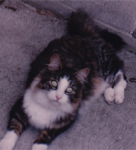low oxygen
low oxygen
I bought a oxymeter and find my levels are 88 to 94 most days ,is that a normal reading thankyou
-
SleepyToo2
- Posts: 1005
- Joined: Sun Sep 11, 2011 7:55 am
- Location: North of Philadelphia, PA
Re: low oxygen
I can't comment on whether it is normal or not. It might be normal for you. You might not be locating the oximeter correctly to record your O2 levels accurately. Your oximeter might not be recording accurately. You should discuss it with your physician. Do you have any symptoms that suggest it may be abnormal?
_________________
| Mask: AirFit™ P10 Nasal Pillow CPAP Mask with Headgear |
| Additional Comments: Use SleepyHead software. |
Not a medical professional - just a patient who has done a lot of reading
Re: low oxygen
I am going to see my doctor on tues ,my heart has been jumping a bit not all the time but I will get it checked.
Re: low oxygen
Those are not bad averages... lower would be not so great, but if all else is good, I wouldn't worry too much.
Re: low oxygen
bring your oximeter with you, to check against the one they have. That way you know if it reads correctly or not. But those were what my numbers tended to run prior to my bipap, now I run a few points higher, even during the day.
Re: low oxygen
How often does your heart "jump around a bit"?? If it happens every day a 24 hour Holter monitor might not be a bad idea.
If it only happens a couple of times a week or a few times a month a 21 day event monitor might not be a bad idea.
When does the 88% Sp02 occur? When you are just sitting and resting? When you are somewhat active? Just sitting and resting or walking from one room to another 88%-94% is a bit on the low side. Not alarmingly so but still a bit low.
Do you have any risk factors for heart or lung problems?? Smoker? Prior smoker? Asthma? Allergies? COPD? Any cardiac problems? Heart valve problems? Circulation problems? High blood pressure? Low blood pressure?
How old are you? Your age would probably be a factor in how much interest or concern your doctor would have about these symptoms. I would think they would be of more concern at 30 years of age than at 70 years of age for example.
If it only happens a couple of times a week or a few times a month a 21 day event monitor might not be a bad idea.
When does the 88% Sp02 occur? When you are just sitting and resting? When you are somewhat active? Just sitting and resting or walking from one room to another 88%-94% is a bit on the low side. Not alarmingly so but still a bit low.
Do you have any risk factors for heart or lung problems?? Smoker? Prior smoker? Asthma? Allergies? COPD? Any cardiac problems? Heart valve problems? Circulation problems? High blood pressure? Low blood pressure?
How old are you? Your age would probably be a factor in how much interest or concern your doctor would have about these symptoms. I would think they would be of more concern at 30 years of age than at 70 years of age for example.
_________________
| Mask: Quattro™ FX Full Face CPAP Mask with Headgear |
| Additional Comments: PR SystemOne BPAP Auto w/Bi-Flex & Humidifier - EncorePro 2.2 Software - Contec CMS-50D+ Oximeter - Respironics EverFlo Q Concentrator |
Women are Angels. And when someone breaks our wings, we simply continue to fly.....on a broomstick. We are flexible like that.
My computer says I need to upgrade my brain to be compatible with its new software.
My computer says I need to upgrade my brain to be compatible with its new software.
-
HoseCrusher
- Posts: 2744
- Joined: Tue Oct 12, 2010 6:42 pm
Re: low oxygen
Another consideration is what elevation you are at. There is less oxygen at higher elevations.
_________________
| Mask: Brevida™ Nasal Pillow CPAP Mask with Headgear |
| Additional Comments: Machine is an AirSense 10 AutoSet For Her with Heated Humidifier. |
SpO2 96+% and holding...
Re: low oxygen
Great reminder, HoseCrusher!!! I completely forgot about and didn't think of that!!!!!!
A couple of years ago there was a thread, I think in this forum but maybe one of the others, where someone had had their sleep and titration study done "down in the valley" but lived "in the mountains" who was having a devil of a time getting acclimated to CPAP therapy and finding the pressure setting(s) he/she needed.
A couple of years ago there was a thread, I think in this forum but maybe one of the others, where someone had had their sleep and titration study done "down in the valley" but lived "in the mountains" who was having a devil of a time getting acclimated to CPAP therapy and finding the pressure setting(s) he/she needed.
_________________
| Mask: Quattro™ FX Full Face CPAP Mask with Headgear |
| Additional Comments: PR SystemOne BPAP Auto w/Bi-Flex & Humidifier - EncorePro 2.2 Software - Contec CMS-50D+ Oximeter - Respironics EverFlo Q Concentrator |
Women are Angels. And when someone breaks our wings, we simply continue to fly.....on a broomstick. We are flexible like that.
My computer says I need to upgrade my brain to be compatible with its new software.
My computer says I need to upgrade my brain to be compatible with its new software.
Re: low oxygen
Thankyou for your replys, I am 73 and do not smoke and really good health, but the heart jumping has only just started about a week ago and seems to do it in the afternoons.yes I think a heart halter would be a good idea,I will talk to my doctor, I have been on cpap 3 years and doing very well now.I sleep good and feel awake during the day. glad to say my fuzzy head has gone and that is wonderful.thankyou again
- torontoCPAPguy
- Posts: 1015
- Joined: Mon Dec 28, 2009 11:27 am
- Location: Toronto Ontario/Buffalo NY
Re: low oxygen
Your heart "jumping" is a sign of something that needs to get checked out in a hurry. Do not wait too long. My heart 'jumping' turned out to be Atrial Fibrillation which on its own will bring down SpO2. You need a recording pulse oximeter so you can record your SpO2 all night long. I would be that your SpO2 drops below 90% regularly during the night, especially if you suffer from apnea.
On its own, an SpO2 reading of anything below 89% is considered respiratory distress by paramedics and begets a trip to the hospital and immediate oxygen on your face. 88% while awake is not too bad but it is significant in that it indicates there may be other factors in play. Again, you want to know what it is during the night and if you are dropping much below 88% during the night, even for brief periods, you want it attended to immediately as it is likely shooting up your BP and can lead to more serious issues.
What I have found is that I actually needed O2 during the night in order to stay above 90% and get a good night of sleep (not to mention the reduced risk of stroke, myocardial infarction, deep vein thrombosis and so on). They were testing me for allergies and the whole 9 yards when I said "the heck with this" and went out and purchased an oxygen concentrator and started infusing pure O2 into my airline, bringing the oxygen content of what I was breathing from 21% (normal room air at sea level) to about 35%. My O2 at night immediately went to 95% all night and I slept like a log. I was then diagnosed with Atrial Fibrillation (likely brought on by the sleep apnea) and finally started on TIKOSYN in December. I am now in the process of titrating my oxygen infusion down from 4L/M (which in itself is not a whole lot of O2). My SpO2 generally stays up at around 99% even while in REM. OK, but probably better at 95%.
ANY SpO2 under 90% is worthy of investigation, especially during the daytime when you are in motion. That is just my humble opinion but is based on much reading and experience with the beasts.
If you want to know more about serum oxygen levels and what they do you need only google SpO2 and bypass all the sales hits.
On its own, an SpO2 reading of anything below 89% is considered respiratory distress by paramedics and begets a trip to the hospital and immediate oxygen on your face. 88% while awake is not too bad but it is significant in that it indicates there may be other factors in play. Again, you want to know what it is during the night and if you are dropping much below 88% during the night, even for brief periods, you want it attended to immediately as it is likely shooting up your BP and can lead to more serious issues.
What I have found is that I actually needed O2 during the night in order to stay above 90% and get a good night of sleep (not to mention the reduced risk of stroke, myocardial infarction, deep vein thrombosis and so on). They were testing me for allergies and the whole 9 yards when I said "the heck with this" and went out and purchased an oxygen concentrator and started infusing pure O2 into my airline, bringing the oxygen content of what I was breathing from 21% (normal room air at sea level) to about 35%. My O2 at night immediately went to 95% all night and I slept like a log. I was then diagnosed with Atrial Fibrillation (likely brought on by the sleep apnea) and finally started on TIKOSYN in December. I am now in the process of titrating my oxygen infusion down from 4L/M (which in itself is not a whole lot of O2). My SpO2 generally stays up at around 99% even while in REM. OK, but probably better at 95%.
ANY SpO2 under 90% is worthy of investigation, especially during the daytime when you are in motion. That is just my humble opinion but is based on much reading and experience with the beasts.
If you want to know more about serum oxygen levels and what they do you need only google SpO2 and bypass all the sales hits.
_________________
| Mask: Mirage Quattro™ Full Face CPAP Mask with Headgear |
| Humidifier: S9™ Series H5i™ Heated Humidifier with Climate Control |
| Additional Comments: Respironics Everflo Q infusing O2 into APAP line to maintain 95% SaO2; MaxTec Maxflo2 Oxygen Analyzer; Contec CMS50E Recording Pulse Oxymeter |
Fall colours. One of God's gifts. Life is fragile and short, savour every moment no matter what your problems may be. These stunning fall colours from my first outing after surviving a month on life support due to H1N1.











